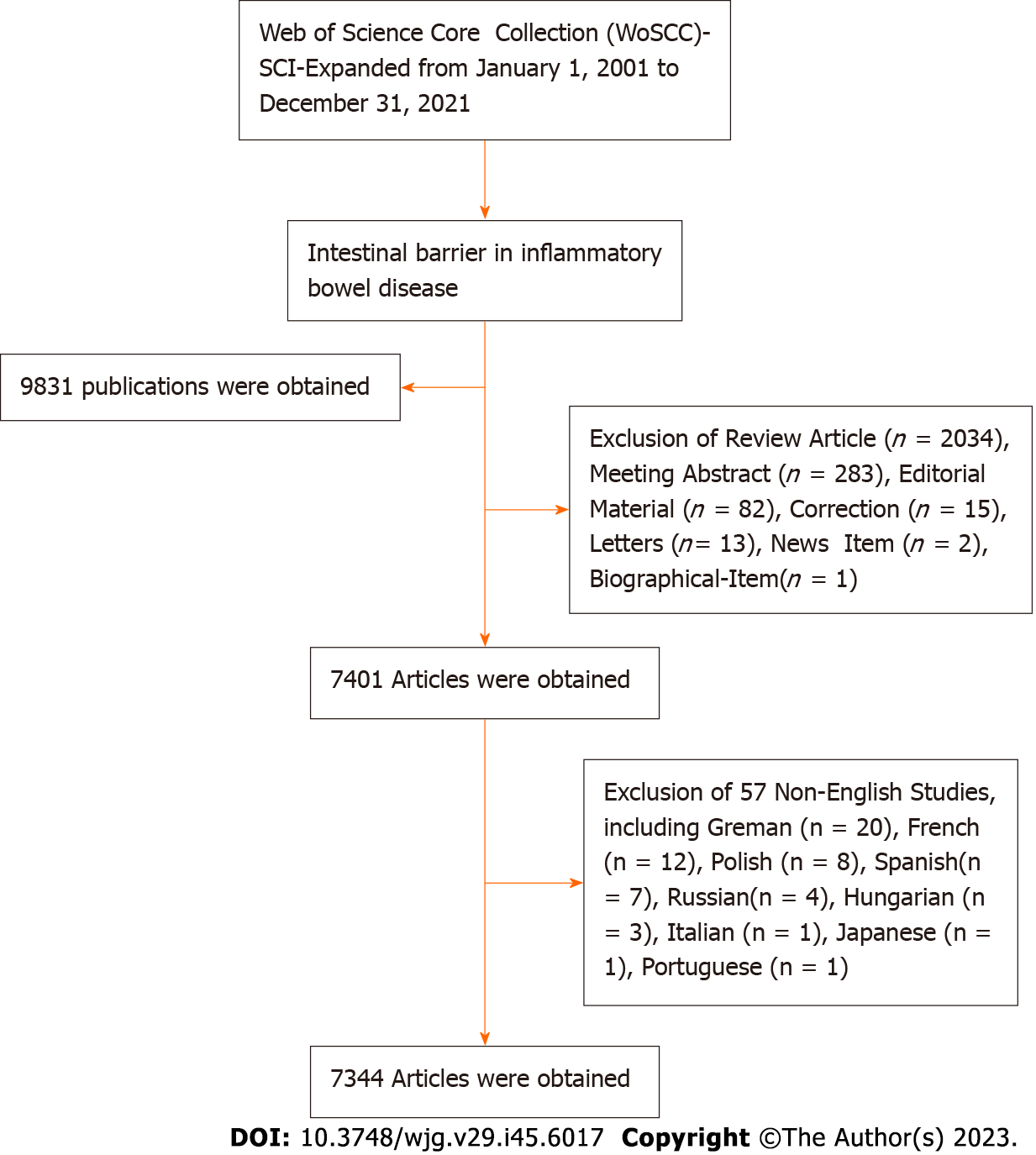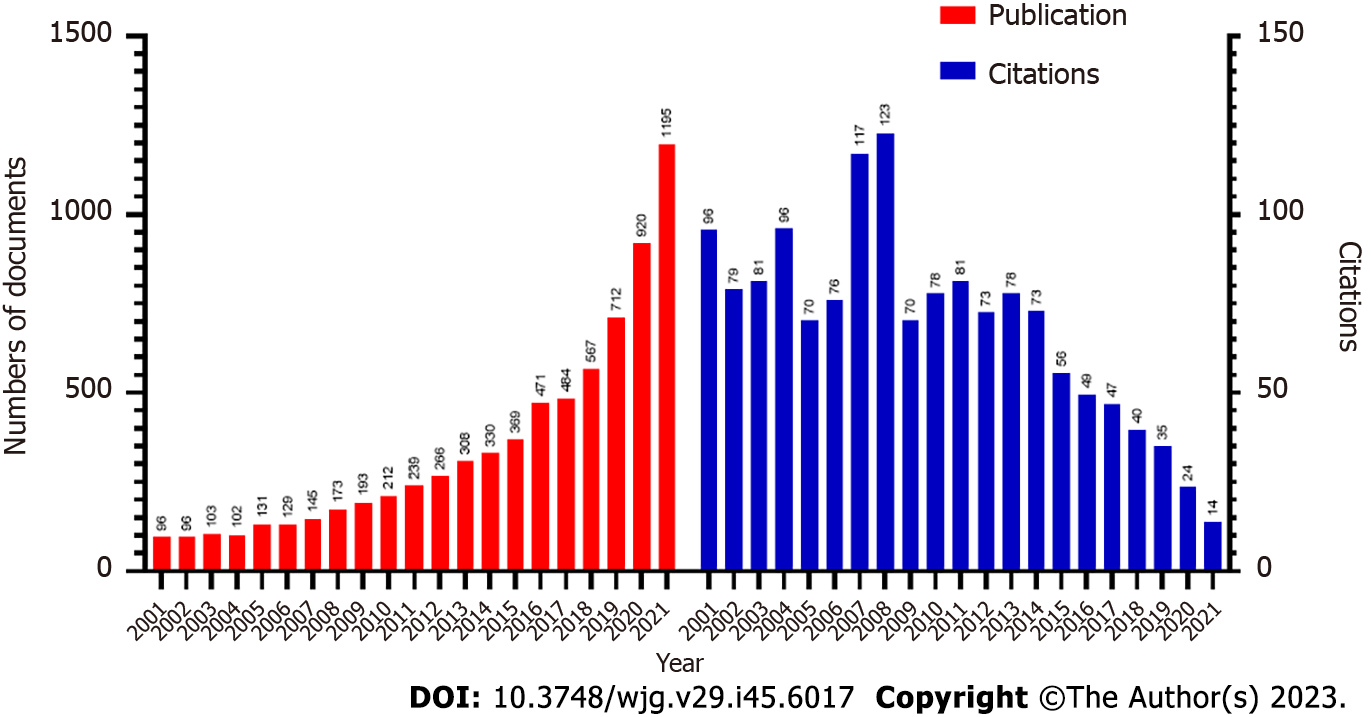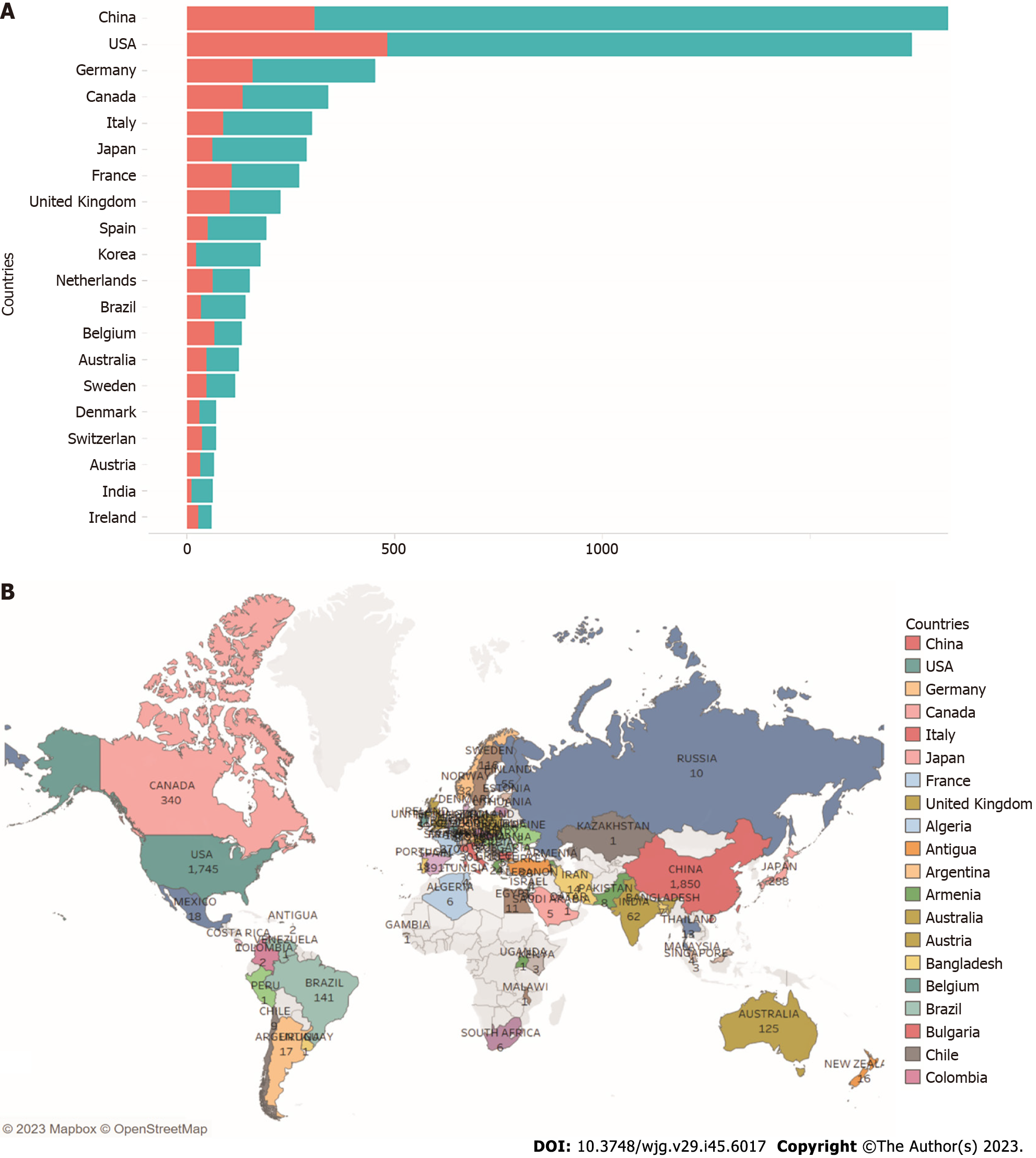Published online Dec 7, 2023. doi: 10.3748/wjg.v29.i45.6017
Peer-review started: October 8, 2023
First decision: October 29, 2023
Revised: November 5, 2023
Accepted: November 17, 2023
Article in press: November 17, 2023
Published online: December 7, 2023
Processing time: 54 Days and 5.1 Hours
The primary objective of this investigation was to examine the evolving traje
Core Tip: The intricate architecture and operation of the intestinal mucosal barrier assume a pivotal role in maintaining the delicate equilibrium of both physiological and immune processes within the confines of the intestinal milieu. This study employed advanced bibliometric methodologies to investigate evolving paradigms and conspicuous research domains within the ambit of research on intestinal barriers with a specific focus on inflammatory bowel disease. The results reveal swift progress within the realm of intestinal barrier research characterized by a proliferation of expansive collaborative endeavors.
- Citation: Luan WY, Yang Z, Chen XD, Zhang TT, Zhang F, Miao YD. Intestinal barrier in inflammatory bowel disease: A bibliometric analysis. World J Gastroenterol 2023; 29(45): 6017-6021
- URL: https://www.wjgnet.com/1007-9327/full/v29/i45/6017.htm
- DOI: https://dx.doi.org/10.3748/wjg.v29.i45.6017
We have recently examined the scholarly work authored by Zhou et al[1] titled "Intestinal barrier in inflammatory bowel disease (IBD): A bibliometric and knowledge-map analysis". The primary objective of this study was to consider the evolving trends and focal points within the realm of intestinal barrier research in the context of IBD. Given that barrier surfaces, which are composed of specialized epithelial cells, serve as the critical demarcation between the host's internal milieu and the external environment and are indispensable for the preservation of proper physiological and immunological equilibrium, we acknowledge the profound significance of this investigation[2-4]. Nevertheless, we wish to proffer a series of thoughtful recommendations pertaining to the information retrieval methodologies employed in this study.
First and foremost, within the domain of bibliometric inquiries, the meticulous formulation of search strategies assumes paramount importance. The authors have duly noted their utilization of the Web of Science Core Collection (WoSCC) as the primary source of original data, a judicious choice in our estimation. However, it is worth noting that WoSCC encompasses at least 10 subdatabases, including the Science Citation Index Expanded (SCI-Expanded), Social Sciences Citation Index, Emerging Sources Citation Index, Arts and Humanities Citation Index, Conference Proceedings Citation Index-Science, Current Chemical Reactions, Conference Proceedings Citation Index-Social Science and Humanities, Book Citation Index-Science, Index Chemicus, and Book Citation Index-Social Sciences and Humanities. In our view, it may not be appropriate to incorporate all of these subdatabases for the retrieval of eligible articles. For instance, utilizing the retrieval formula employed by the authors, no relevant studies could be located in AHCI, CCR-EXPANDED, and IC[5,6]. Consistent with this perspective, some scholars also contend that it is inappropriate to employ such a diverse array of databases that vary in type and level within a singular bibliometric analysis[7,8]. Among these, SCI-Expanded stands out as the most fitting and widely accepted choice for conducting bibliometric analyses[9,10].
Another pivotal aspect that warrants careful consideration pertains to the appropriateness of topic search (TS) for bibliometric endeavors. The "TS" approach, by design, designates a publication as relevant when the search term appears in the "Title (TI)," "Abstract (AB)," "Author keywords (AK)," or "Keywords plus (KP)." It is imperative to determine that "KP" is generated through WoSCC's automated computational algorithms independent of author input. Consequently, the inclusion of "KP" during the search process may inadvertently include a multitude of extraneous publications[11]. In our experience, the prudent course of action involves relying on "TI," "AB," and "AK" as qualifiers to ensure a more precise and semantically meaningful dataset for bibliometric analysis.
Furthermore, it is of paramount importance to recognize that the effectiveness of a search formula hinges on its comprehensiveness because an overly simplistic approach may unintentionally omit pertinent publications. In the study by Zhou et al[1], the authors' reliance on the phrases “IBD” OR “ulcerative colitis” OR “Crohn’s disease” is insufficient for capturing the entirety of relevant research. Additionally, in Zhou et al's study, the publication period spanned from 2001 to 2021[1]; however, the exact commencement and conclusion dates were not provided. Moreover, there is some inconsistency in the description of the screening timeframe, with the Methods section indicating 2001-2021 while the AB and results sections mention 2002-2022. Hence, further clarification regarding the precise timeframe for the inclusion of literature is warranted.
As part of our contribution to refining the retrieval strategy, we posit that it is prudent to incorporate synonymous terms and nomenclature associated with “IBD”. In our opinion, the authors should additionally incorporate the subsequent terms into the search equation: “Intestinal inflammation” and ”gut inflammation.” Similarly, for “intestinal barrier,” the search formula included “intestinal barrier”, “gut barrier”, “mucosal barrier,” “intestinal permeability”, ”epithelial barrier”, “intestinal tight junction”, “intestinal epithelium”, and “intestinal integrity”. Furthermore, numerous terms exhibit both plural and singular variations. The authors could consider employing various wildcards, such as “*”, which signifies that it can replace any number of characters. For instance, “IBD*” would return the terms “IBD” and “IBDs”. The flowchart of the literature screening is indicated in Figure 1. Our suggested retrieval formula is summarized in Supplementary material.
The refined search query, incorporating a more extensive array of relevant terminologies, undeniably facilitated a more exhaustive exploration of the pertinent literature. Our search, conducted from January 1, 2001 to December 31, 2021, retrieved a total of 9831 records. After the careful exclusion of literature of diverse types and non-English studies, we ultimately preserved 7344 articles for our analysis. The annual publication trends are elucidated in Figure 2 and the corresponding author's countries and country scientific production are manifested in Figure 3.
In contrast to the findings presented by Zhou et al[1], our study, which used a more refined retrieval scope focusing on "TI/AK/AB," identified a larger pool of related studies on the intestinal barrier in IBD (7344 vs 4482). It is noteworthy that such a substantial change in the number of publications can exert a significant impact on various quantitative data points, including those related to the most prolific countries (as depicted in Figure 3), institutions, and authors. Therefore, to mitigate potential bias, it is imperative to carefully formulate an appropriate retrieval formula when conducting bibliometric analyses. From our perspective, seeking expert consultation to tailor search keywords to the specific domain of study is an essential and prudent step.
It is crucial to underscore that the significant fluctuations in publication numbers can wield a profound influence on various quantitative aspects, including publication counts, citations, the most prolific countries/regions, institutions, authors, cited authors, journals, cited academic journals, keyword co-occurrence, clusters, and bursts. This underscores the critical importance of meticulously devising an appropriate retrieval formula, which serves as the bedrock for unbiased bibliometric analysis. In our considered view, soliciting expert consultation on search keywords tailored to the specific domain of study is an indispensable step in this process.
In conclusion, while we extend our commendations to Zhou et al[1] for their meticulous work, we firmly believe that our proposal complements the precision and accuracy of the data analysis of trends in research on "intestinal barrier in IBD" during the last two decades.
Provenance and peer review: Unsolicited article; Externally peer reviewed.
Peer-review model: Single blind
Specialty type: Gastroenterology and hepatology
Country/Territory of origin: China
Peer-review report’s scientific quality classification
Grade A (Excellent): A
Grade B (Very good): B
Grade C (Good): 0
Grade D (Fair): 0
Grade E (Poor): E
P-Reviewer: Ho YS, Taiwan; Tulassay Z, Hungary; Vorobjova T, Estonia S-Editor: Qu XL L-Editor: Wang TQ P-Editor: Yu HG
| 1. | Zhou F, Wu NZ, Xie Y, Zhou XJ. Intestinal barrier in inflammatory bowel disease: A bibliometric and knowledge-map analysis. World J Gastroenterol. 2023;29:5254-5267. [RCA] [PubMed] [DOI] [Full Text] [Full Text (PDF)] [Cited by in RCA: 8] [Reference Citation Analysis (3)] |
| 2. | Matsuzawa-Ishimoto Y, Yao X, Koide A, Ueberheide BM, Axelrad JE, Reis BS, Parsa R, Neil JA, Devlin JC, Rudensky E, Dewan MZ, Cammer M, Blumberg RS, Ding Y, Ruggles KV, Mucida D, Koide S, Cadwell K. The γδ IEL effector API5 masks genetic susceptibility to Paneth cell death. Nature. 2022;610:547-554. [RCA] [PubMed] [DOI] [Full Text] [Cited by in Crossref: 1] [Cited by in RCA: 50] [Article Influence: 12.5] [Reference Citation Analysis (0)] |
| 3. | Bourgonje AR, Vogl T, Segal E, Weersma RK. Antibody signatures in inflammatory bowel disease: current developments and future applications. Trends Mol Med. 2022;28:693-705. [RCA] [PubMed] [DOI] [Full Text] [Cited by in RCA: 21] [Reference Citation Analysis (0)] |
| 4. | Kang S, Kim J, Park A, Koh M, Shin W, Park G, Lee TA, Kim HJ, Han H, Kim Y, Choi MK, Park JH, Lee E, Cho HS, Park HW, Cheon JH, Lee S, Park B. TRIM40 is a pathogenic driver of inflammatory bowel disease subverting intestinal barrier integrity. Nat Commun. 2023;14:700. [RCA] [PubMed] [DOI] [Full Text] [Full Text (PDF)] [Cited by in Crossref: 22] [Cited by in RCA: 31] [Article Influence: 10.3] [Reference Citation Analysis (0)] |
| 5. | Ho YS. Commentary: Trends and Development in Enteral Nutrition Application for Ventilator Associated Pneumonia: A Scientometric Research Study (1996-2018). Front Pharmacol. 2019;10:1056. [RCA] [PubMed] [DOI] [Full Text] [Full Text (PDF)] [Cited by in Crossref: 9] [Cited by in RCA: 6] [Article Influence: 0.9] [Reference Citation Analysis (0)] |
| 6. | Ho YS. Rebuttal to: Su et al. "The neurotoxicity of nanoparticles: A bibliometric analysis," Vol. 34, pp. 922-929. Toxicol Ind Health. 2019;35:399-402. [RCA] [PubMed] [DOI] [Full Text] [Cited by in Crossref: 9] [Cited by in RCA: 13] [Article Influence: 1.9] [Reference Citation Analysis (0)] |
| 7. | Cheng K, He Y, Gu S, Wu H, Li C. A commentary on 'Evolutionary patterns and research frontiers in neoadjuvant immunotherapy: a bibliometric analysis'. Int J Surg. 2023;109:2829-2830. [RCA] [PubMed] [DOI] [Full Text] [Full Text (PDF)] [Cited by in Crossref: 14] [Cited by in RCA: 19] [Article Influence: 6.3] [Reference Citation Analysis (0)] |
| 8. | de Castilhos Ghisi N, Zuanazzi NR, Fabrin TMC, Oliveira EC. Glyphosate and its toxicology: A scientometric review. Sci Total Environ. 2020;733:139359. [RCA] [PubMed] [DOI] [Full Text] [Cited by in Crossref: 60] [Cited by in RCA: 56] [Article Influence: 9.3] [Reference Citation Analysis (0)] |
| 9. | Zhao Y, Zhu Q, Bi C, Yuan J, Chen Y, Hu X. Bibliometric analysis of tumor necrosis factor in post-stroke neuroinflammation from 2003 to 2021. Front Immunol. 2022;13:1040686. [RCA] [PubMed] [DOI] [Full Text] [Full Text (PDF)] [Cited by in RCA: 16] [Reference Citation Analysis (0)] |
| 10. | Pan Y, Deng X, Chen X, Lin M. Bibliometric analysis and visualization of research trends in total mesorectal excision in the past twenty years. Int J Surg. 2023;. [RCA] [PubMed] [DOI] [Full Text] [Full Text (PDF)] [Cited by in Crossref: 6] [Cited by in RCA: 7] [Article Influence: 2.3] [Reference Citation Analysis (0)] |
| 11. | Ho YS. Comments on Research trends of macrophage polarization: a bibliometric analysis. Chin Med J (Engl). 2019;132:2772. [RCA] [PubMed] [DOI] [Full Text] [Full Text (PDF)] [Cited by in Crossref: 18] [Cited by in RCA: 16] [Article Influence: 2.3] [Reference Citation Analysis (0)] |















